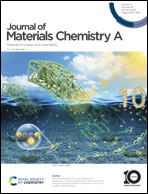Fluorine and phosphorus atoms cooperated on an N-doped 3D porous carbon network for enhanced ORR performance toward the zinc–air batteries†
Abstract
The rational design of low-cost and high-efficiency N-doped porous carbon electrocatalysts for oxygen reduction reaction via a heteroatom doping strategy is pivotal to promoting the commercialization of fuel cells. Herein, we have developed a facile and efficient strategy to prepare a nitrogen-doped carbon network coupled with fluorine and phosphorus atoms by pyrolyzing the mixture of poly3-fluoroaniline coating g-C3N4 with phytic acid. The prepared F/P–N–C-950 catalyst is featured by three-dimensional porous layered architecture, high specific surface area, and abundant high active sites from the synergistic effects between F, P, and N, and showed distinguished oxygen reduction performance with half-wave potential (E1/2) of 0.848 VRHE (exceeding that of commercial Pt/C) and long-term stability (94%). In the homemade zinc–air battery with F/P–N–C-950 as the cathode, it achieved a high peak power density (138 mW cm−2), promising specific capacity (821 mA h g−1), and good multiplicative stability.

- This article is part of the themed collection: 2023 Journal of Materials Chemistry A HOT Papers


 Please wait while we load your content...
Please wait while we load your content...